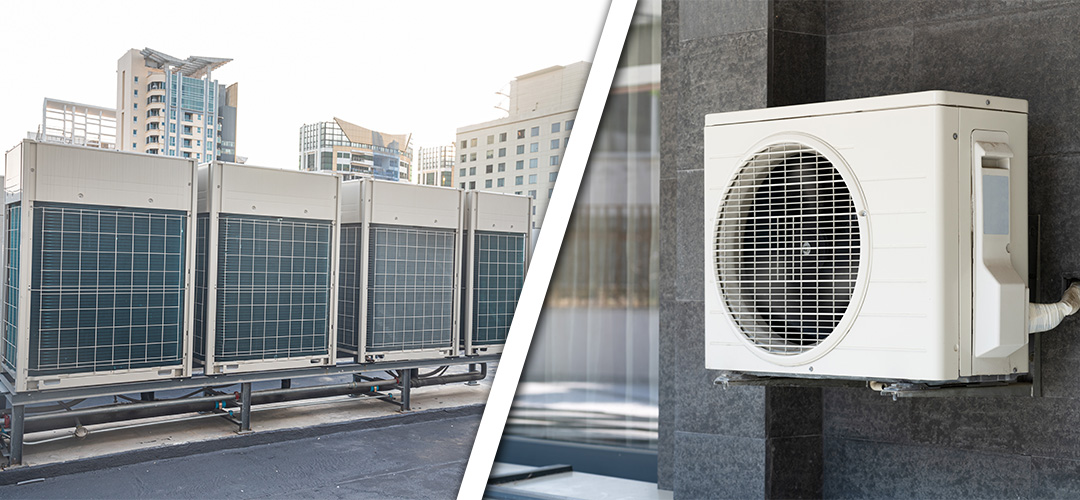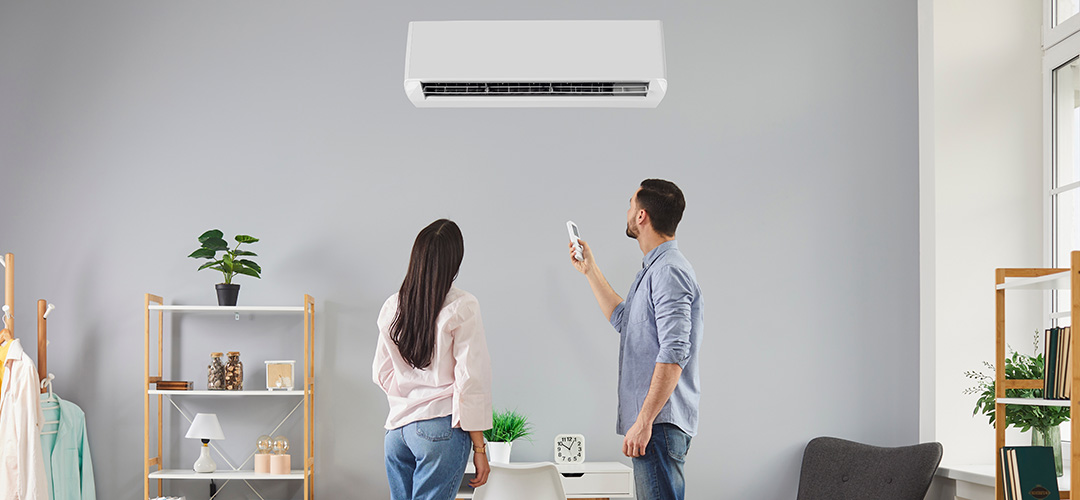When it comes to optimizing the climate control of your commercial space, the choice between HVAC rooftop units and split systems can significantly impact your business’s efficiency and costs. Both systems offer distinct advantages and challenges, and understanding these can empower you to make the best decision for your specific needs.
In this guide, we at Chills AC want to explore the nuances of HVAC units vs. split systems, considering factors like installation flexibility, space requirements, energy efficiency, and maintenance costs. Our goal is to arm you with the knowledge needed to select the ideal commercial air conditioning solution that aligns with your operational goals and budgetary constraints.
Understanding HVAC Systems
HVAC Unit Basics
HVAC units are integral to maintaining a comfortable indoor climate in commercial spaces. These systems perform three primary functions: heating, ventilation, and air conditioning. They regulate temperature, control humidity, and ensure air quality by circulating air through filters and ducts. There are various types of HVAC systems, but the most common for commercial applications are rooftop units and split systems. Rooftop units are typically installed on the roof, saving valuable indoor space and simplifying maintenance access.
On the other hand, split systems are known for their flexibility, consisting of an indoor and outdoor unit connected by refrigerant lines. Each system has its own set of advantages and challenges, making it crucial for business owners to understand their specific needs. By grasping the basics of HVAC units, contractors can better navigate the options available, ensuring an optimal solution for their clients’ commercial air conditioning requirements.
Comparing HVAC Units vs. Split Systems
When comparing HVAC units vs. split systems, several factors come into play. Rooftop units, often seen in commercial settings, provide the advantage of saving indoor space since they are mounted on the building’s roof. This placement allows for easier access for maintenance without disrupting daily operations. In contrast, split systems offer a dual-component setup, with the condenser unit placed outdoors and the air handler inside. This configuration is beneficial for businesses requiring flexible installation options due to structural constraints.
Energy efficiency is another crucial consideration; split systems often excel here due to their ability to cool specific zones rather than the entire building. However, rooftop units can be more cost-effective for larger spaces. Ultimately, the choice between these systems hinges on the specific needs of the business, including budget constraints, space availability, and energy efficiency priorities. Understanding these differences enables contractors to advise clients effectively on the best commercial air conditioning solution.
Installation and Space Considerations
Rooftop Units Installation
Rooftop units are favored in commercial settings due to their efficient use of space. Installing these units on the roof eliminates the need for dedicated floor space, which can be particularly beneficial in densely built environments. This setup not only saves interior space but also reduces noise within the building, as the operational sounds are isolated above. However, installation requires careful planning. The roof must support the unit’s weight, and structural assessments are essential to ensure safety and compliance with building codes.
Additionally, access for maintenance must be considered, as regular servicing is necessary to ensure optimal performance and longevity. Weather conditions are also a factor; rooftops must be equipped to handle the elements, which might entail additional protective measures. By understanding these installation nuances, contractors can guide clients in making informed decisions that align with their operational needs and structural capabilities.
This knowledge ensures a seamless integration of rooftop units into any commercial space.
Split Systems Space Requirements
Split systems stand out for their flexible installation options, making them ideal for businesses with unique space configurations. These systems consist of two main components: an outdoor condenser and an indoor air handler. This separation allows for strategic placement, often resulting in better space utilization within the building. The indoor unit can be mounted on walls, ceilings, or even concealed within ductwork, offering a clean aesthetic and minimal disruption to interior design. Despite this flexibility, certain spatial considerations must be addressed.
Adequate clearance is necessary around both components to ensure efficient airflow and maintenance access. Additionally, the connecting refrigerant lines should be planned to minimize exposure and potential damage. Proper planning during installation is crucial to maximize efficiency and performance. By considering these space requirements, contractors can provide tailored solutions that meet the specific layout and operational needs of their clients, ensuring an effective and aesthetically pleasing commercial air conditioning setup.
Energy Efficiency and Performance
Evaluating Energy Efficiency
Energy efficiency is a pivotal factor when selecting between HVAC units and split systems for commercial use. A system’s energy efficiency directly impacts operational costs and environmental footprint. For rooftop units, efficiency varies based on model and size, with larger units sometimes offering economies of scale. However, they generally cool entire spaces, which might not always be necessary. Split systems often provide better energy efficiency because they allow for zoning, cooling only specific areas as needed.
This targeted approach minimizes energy waste, leading to potential cost savings. When evaluating energy efficiency, it’s essential to consider the Seasonal Energy Efficiency Ratio (SEER) and Energy Efficiency Ratio (EER) ratings. Higher ratings indicate better performance and lower energy consumption. Additionally, investing in systems with advanced features such as variable speed fans and smart thermostats can further enhance efficiency. Contractors should weigh these factors to advise clients on the most energy-efficient and cost-effective commercial air conditioning solutions.
Performance Factors to Consider
When assessing HVAC systems for commercial use, performance is a key criterion. Both rooftop units and split systems have performance attributes that cater to different needs. Rooftop units are generally robust, capable of handling larger cooling loads, making them suitable for extensive commercial spaces. However, their performance can be affected by external weather conditions due to their rooftop placement. Split systems, on the other hand, offer precise temperature control and are excellent for zoned cooling, providing consistent comfort where it’s needed most. They are less affected by outdoor conditions since their indoor components are shielded.
Noise levels are another performance aspect; split systems tend to be quieter indoors because the noisier components are placed outside. Additionally, modern systems come with features like variable speed motors and programmable thermostats that enhance overall performance. Contractors should consider these performance factors to recommend systems that align with the specific operational demands and comfort requirements of their clients’ businesses.
Maintenance and Cost Implications
Maintenance Needs for Rooftop Units
Rooftop units require regular maintenance to ensure optimal performance and longevity. Positioned on the roof, these units are exposed to weather conditions that can accelerate wear and tear. Regular inspections are necessary to check for damage, clean components, and replace filters. Maintenance tasks should include checking the integrity of seals and insulation, ensuring that drain lines are clear, and verifying that electrical connections are secure.
Given their location, rooftop units can be easier to access for maintenance without disrupting indoor activities, although safety measures must be taken when working at height. The cost of maintaining rooftop units can vary based on the unit’s size and complexity, but routine upkeep is vital to prevent costly repairs or replacements down the line.
Contractors should communicate these maintenance needs to clients, emphasizing the importance of scheduled servicing to maintain efficiency and avoid unexpected operational disruptions in their commercial air conditioning systems.
Cost Analysis of Split Systems
Split systems offer distinct cost implications that are crucial for businesses to consider. Initially, these systems might have higher installation costs compared to rooftop units due to the need for connecting refrigerant lines and potentially modifying existing structures. However, split systems can lead to cost savings over time through enhanced energy efficiency and targeted cooling.
By cooling only specific areas, they reduce energy consumption and operational costs. Maintenance costs for split systems can also be lower, as their design often leads to fewer components exposed to harsh weather conditions, reducing wear and tear. Moreover, modern split systems can come equipped with advanced energy-saving features, further offsetting operational expenses. When conducting a cost analysis, contractors should evaluate both the upfront and long-term costs, considering the potential savings in energy bills and maintenance. This comprehensive view helps clients understand the financial implications and benefits of choosing split systems for their commercial air conditioning needs.
Making the Right Choice
Factors Influencing Your Decision
Choosing between HVAC rooftop units and split systems involves several critical factors that should align with the specific needs of a business. Space availability is a primary consideration; rooftop units are ideal for businesses with limited indoor space, while split systems are suitable for environments requiring flexible placement. Budget constraints also play a significant role; while rooftop units might offer lower initial costs, split systems can provide long-term energy savings. Operational requirements, such as the need for zoned cooling or specific temperature control, can also dictate the choice. Additionally, the local climate might influence the decision, as rooftop units are more exposed to weather extremes.
Maintenance capabilities and resources should be assessed, ensuring that the selected system can be easily and cost-effectively maintained. Contractors should guide clients through these factors, offering insights that balance immediate needs with long-term benefits, ultimately empowering them to choose the most appropriate commercial air conditioning system for their operations.
Tailoring the Solution to Your Business
Tailoring an HVAC solution to your business involves a careful assessment of your unique operational demands and constraints. Start by evaluating the size and layout of your commercial space to determine the most effective system type—whether it’s a rooftop unit or a split system. Consider the specific climate control needs of your operations, including any requirements for zoned cooling or precise humidity levels. Factor in your budget, both for initial installation and ongoing operational costs, to ensure the solution is financially viable in the long term.
Additionally, think about future scalability; select a system that can adapt to potential business growth or changes in your space. Contractors can provide valuable insights, working closely with you to understand these details and recommend a system that aligns with your business goals. By customizing the HVAC solution, you ensure that your commercial air conditioning system supports your operational efficiency and contributes to a comfortable, productive environment. Consult our experts for more information and support!



